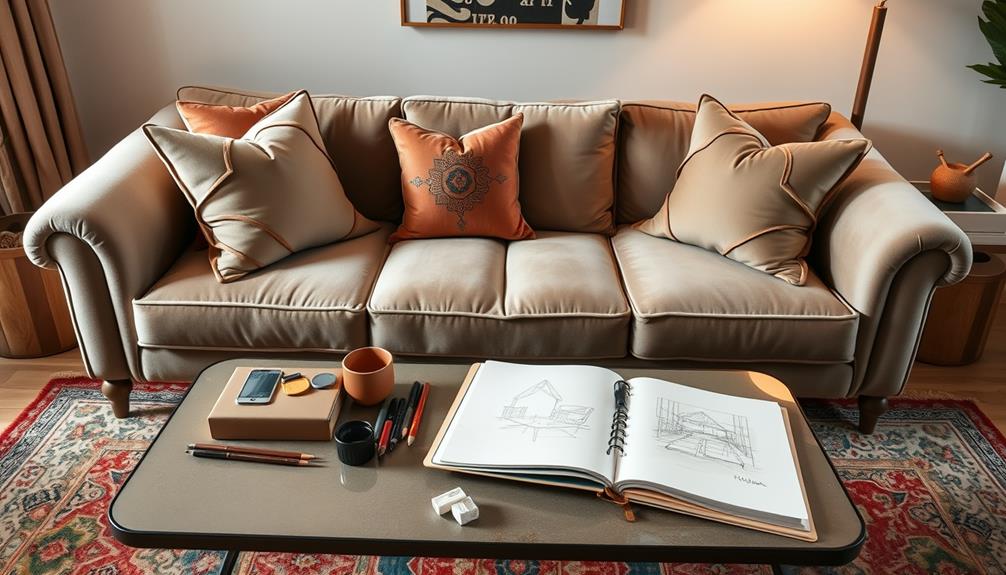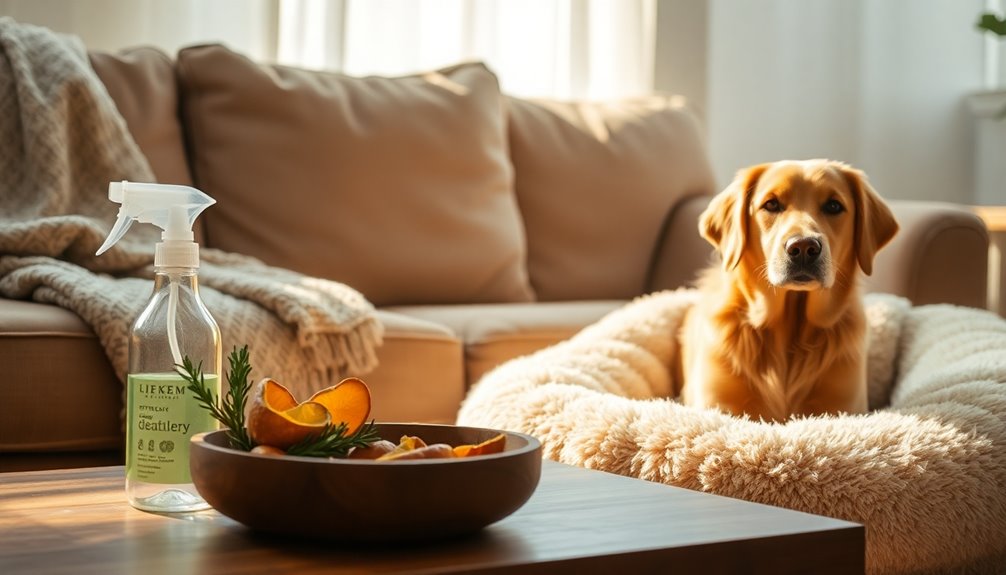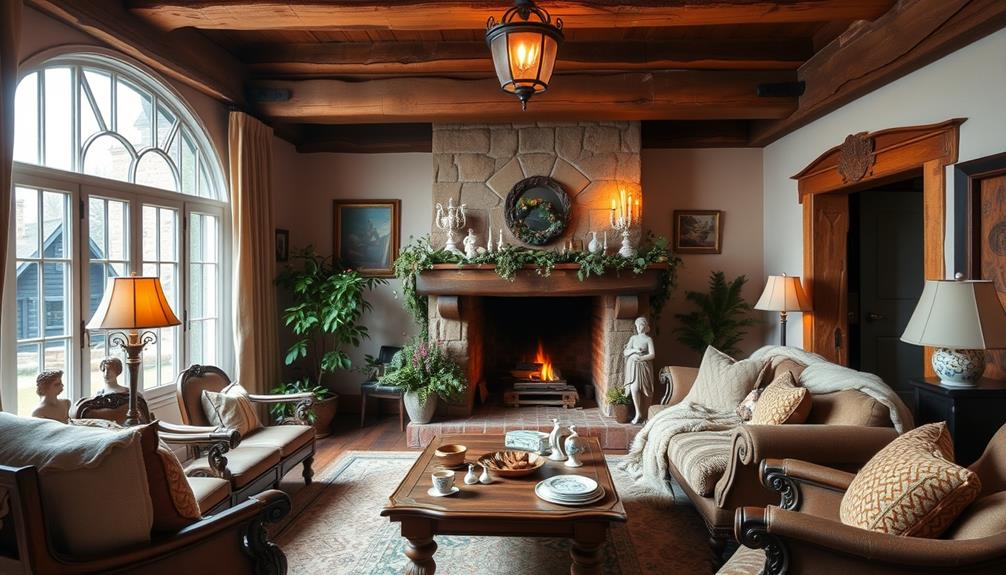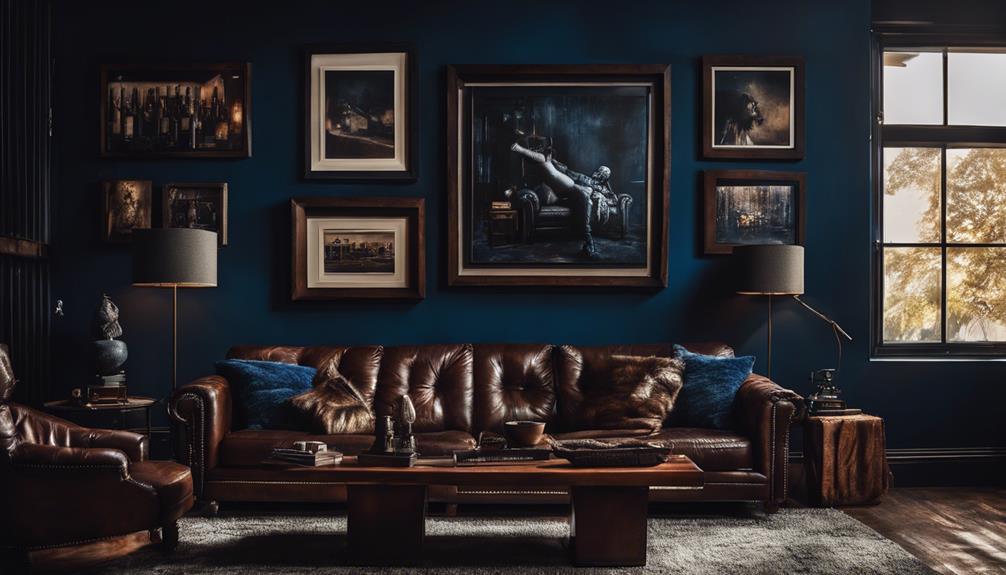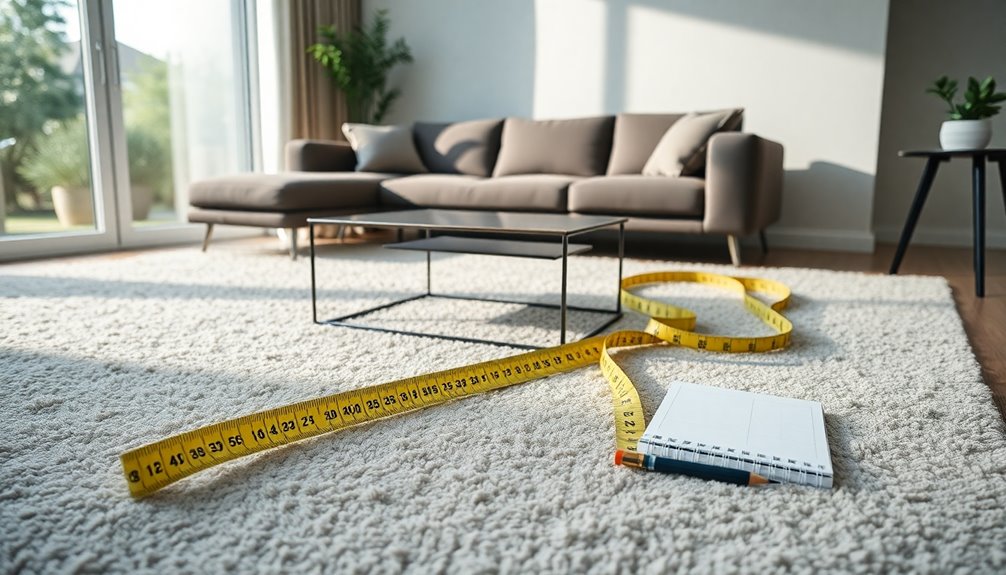To create a sofa, begin by outlining basic shapes such as rectangles for the frame and cushions. Employ a ruler for precise lines and make sure to maintain the correct proportions between the body, cushions, and armrests. Incorporate smaller rectangles for the cushions and test out soft, curved edges for a cozy appearance. Remember to define the armrests, infusing them with distinctive shapes for added character. Enhance your sofa drawing with shading and patterns to give it a lifelike quality. As you progress, you’ll uncover more methods and styles to enhance your artistic skills even further! After mastering the fundamentals, delve into more advanced techniques to produce inventive and unique sofa designs. Seek inspiration from interior design publications, furniture shops, or online sources like Pinterest for dream minecraft sofa concepts. Playing around with diverse textures and patterns can elevate your drawings, propelling your sofa designs to new heights. Embrace your creativity – there are no boundaries to what you can achieve!
Key Takeaways
- Begin by sketching the sofa's structure using basic shapes like rectangles for the body and cushions.
- Maintain consistent proportions by measuring widths, heights, and depths from reference sofas.
- Add details like rounded armrests and cushions for a comfortable look, using smaller shapes.
- Incorporate texture and shading techniques to create a three-dimensional appearance in your drawing.
- Experiment with colors and patterns to personalize your sofa design and enhance visual interest.
Overview of the Tutorial
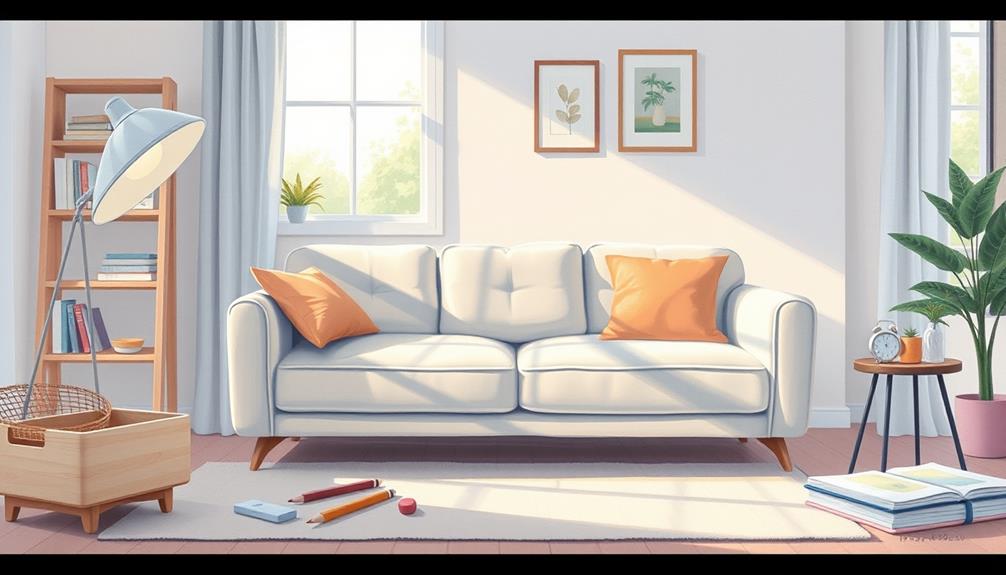
In this fun tutorial, you'll learn how to draw a sofa step by step, making it perfect for kids and beginners. You'll discover how easy it's to create a cozy sofa using basic shapes like rectangles and ovals. This approach breaks down the drawing process, so you won't feel overwhelmed.
Incorporating elements of interior design basics can inspire your creativity and help you visualize how your drawing fits into a room setting.
Each step is designed to be engaging and simple, allowing you to follow along at your own pace. As you draw, you'll have the chance to express your creativity, customizing your sofa to make it uniquely yours. Whether you want a modern look or a classic design, the tutorial gives you the freedom to explore different styles.
To make the experience even more enjoyable, there'll be background music accompanying the lesson. This helps create a pleasant atmosphere, making it easier to focus on your drawing.
Don't worry if you're new to drawing; this tutorial emphasizes building confidence as you go. By the end, you'll have a fantastic sofa drawing that you can be proud of, boosting your artistic skills along the way.
Drawing Materials Needed

Gathering the right materials is essential for your sofa drawing experience. Start with a sketchbook or plain paper; make sure it has ample space for your design. You'll want to use pencils for your initial sketches, as they allow for easy adjustments and corrections before you finalize your work.
Don't forget to keep erasers handy; they're invaluable for refining shapes and correcting any mistakes as you go along. Additionally, consider utilizing energy-efficient appliances as a source of inspiration for modern sofa designs, as they often feature sleek lines and innovative materials.
Once you're satisfied with your outline, it's time to add some color and detail. Markers or colored pencils can really bring your sofa to life, so choose a variety of colors that suit your design.
If you want to achieve clean, straight lines—especially for the sofa's body and armrests—consider using a ruler. This will help you create a polished appearance that enhances your overall drawing.
Basic Shapes to Start

Starting with basic shapes is vital for a successful sofa drawing. Begin by sketching a large rectangle to represent the main body of the sofa, making certain it's proportionate to the size you want. This rectangle will form the foundation of your drawing, so take your time to get it right.
Incorporating calming music while you draw can enhance your creativity and focus, making the process more enjoyable, as music therapy enhances emotional well-being.
Next, draw two smaller rectangles on top of the main body for the backrest and seat cushions. Confirm they align well to create a cohesive look. These shapes will help define the sofa's structure.
For the armrests, add two vertical rectangles on either side of the main body. Curving the tops slightly will give them a more comfortable appearance.
To add more detail, use ovals or smaller rectangles for additional cushions, positioning them on the seat and backrest. This will enhance your drawing and give it a more inviting look.
Remember to keep your initial shapes light and loose. These guidelines are imperative for refining your sofa design later. By focusing on these basic shapes, you'll build a strong foundation for your drawing, making it easier to add details in the next steps.
Adding Cushions and Details
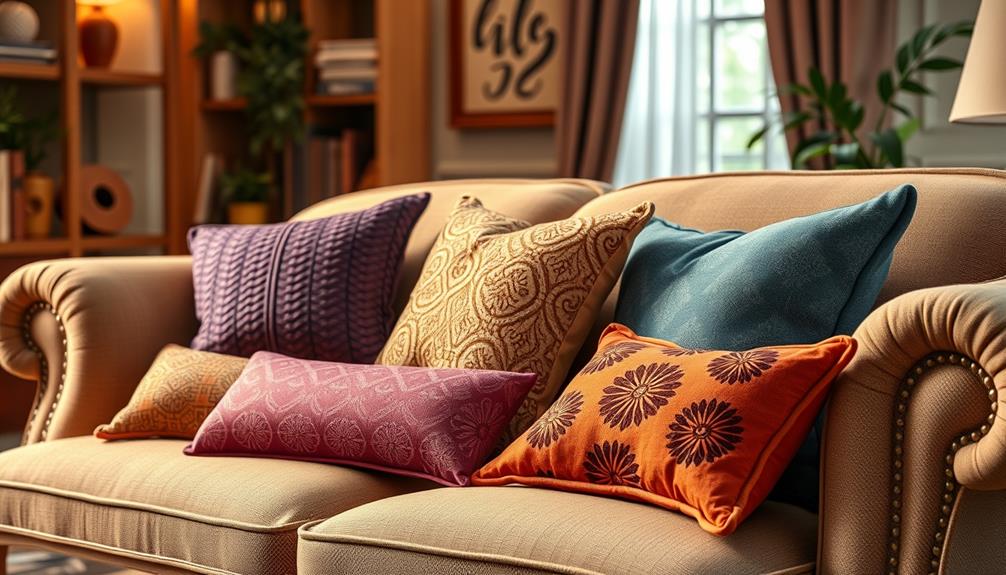
Adding cushions and details transforms your sofa drawing from basic shapes into a more realistic and inviting piece. Incorporating elements such as varied textures and patterns can make your artwork even more engaging.
For instance, consider how essential oils for relaxation can inspire your choice of colors and patterns, making your sofa feel more inviting. By incorporating these elements, you'll elevate your artwork markedly.
Here's how to get started:
- Sketch the Cushions: Begin by adding smaller rectangles or ovals on top of the sofa's main body to represent the seat and back cushions. Vary their shapes and sizes for a dynamic look.
- Create Soft Edges: Use rounded edges for your cushions. This softens the overall appearance and enhances the inviting feel of your sofa.
- Add Texture: Include stitching lines or subtle patterns on the cushions using light pencil strokes. This detail mimics upholstery texture and adds depth to your drawing.
Outlining the Armrests
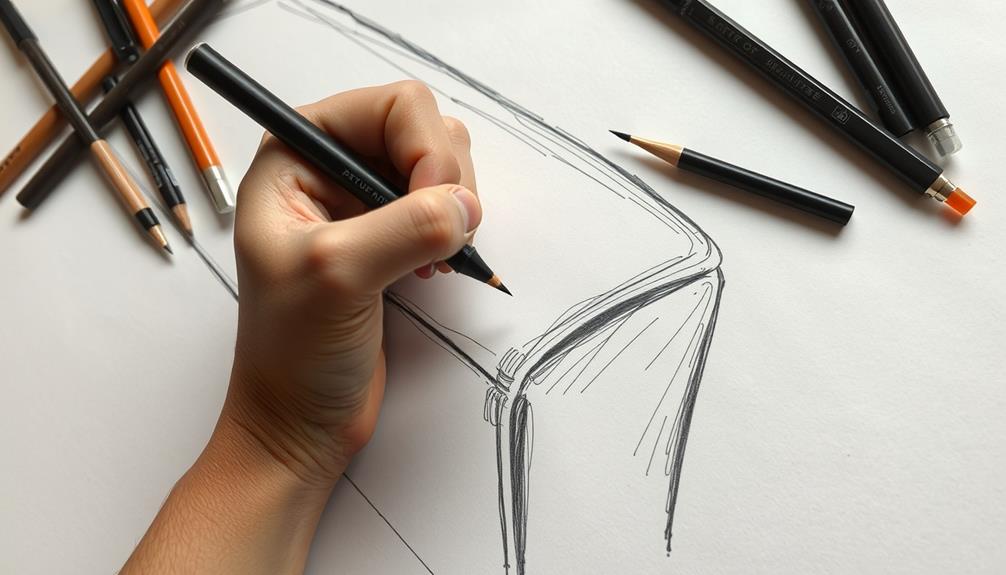
Outlining the armrests is an essential step in giving your sofa drawing a polished and realistic appearance. Begin by sketching two vertical rectangles on either side of the sofa body. Make sure they're proportional to the overall size of your sofa design. To create a more inviting look, curve the top edges of the armrests slightly. This small detail can enhance the comfort feel of your sofa.
Additionally, consider the overall style of your living space as you design your sofa; for example, incorporating elements from DIY Fire Pit Ideas can inspire a cozy outdoor aesthetic that complements your indoor design.
Next, focus on the width of the armrests. They should be wider at the base than at the top to give a sturdy and realistic appearance. This design choice not only adds stability but also contributes to the overall aesthetic of your drawing.
To soften the look, add a slight bevel or rounded edge at the corners of the armrests. This detail will help eliminate harsh lines and create a more harmonious design.
Lastly, don't hesitate to refer to real sofas for inspiration. Explore various armrest styles, like tapered, flared, or chunky, to find what best suits your vision. By incorporating these elements, you'll achieve a more dynamic and visually appealing sofa drawing.
Incorporating Legs and Texture
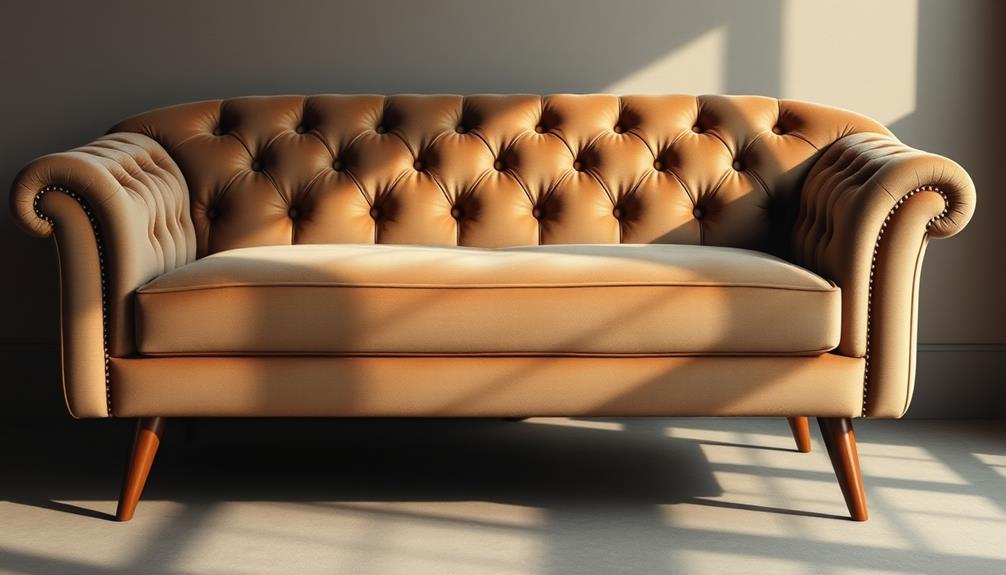
The foundation of your sofa drawing comes alive when you incorporate legs and texture. To achieve a balanced and stable look, focus on the following elements:
- Leg Design: Use straight lines to create rectangular shapes for the legs. You can vary the styles—consider straight, tapered, or turned designs to add character and visual interest. A well-designed leg can reflect the essential elements for farmhouse bedroom design and enhance the overall style of your drawing.
- Texturing Techniques: To represent the upholstery fabric, use short, parallel lines or cross-hatching. This will give the impression of softness and depth, making your sofa appear more inviting.
- Patterned Details: Don't forget to enhance the cushions and upholstery with patterns, like stripes or floral designs. These details can elevate the overall aesthetic and make your drawing stand out.
As you add legs and texture, keep in mind the importance of consistent light and shadow. This technique will create a three-dimensional appearance, allowing your sofa to truly come to life on the page.
Tips for Proportional Drawing
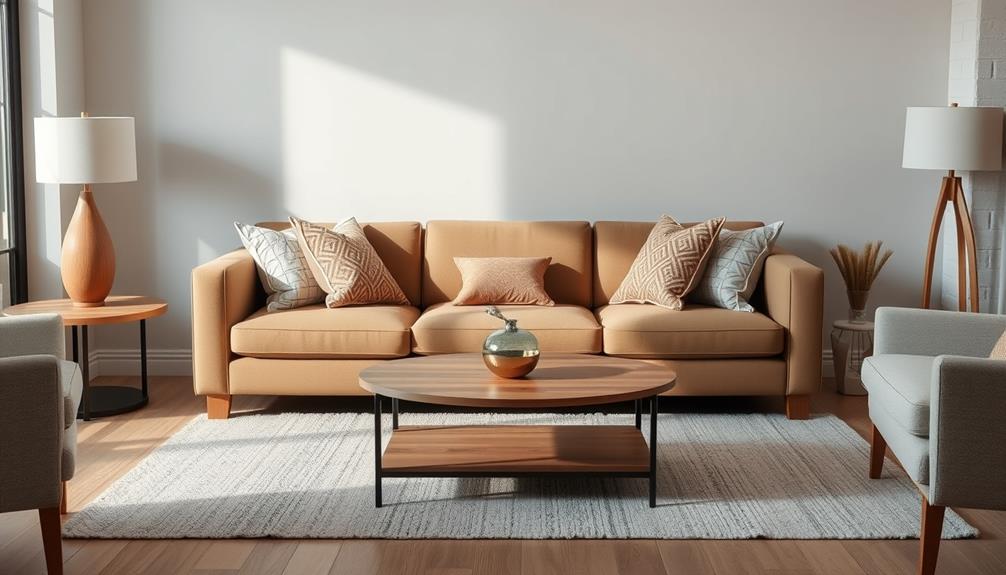
When you're drawing a sofa, start by breaking it down into basic shapes like rectangles and circles to simplify the process. This will help you establish the overall proportions and form before adding in more detailed features. Once you have the basic shape in place, you can then start adding in more specific details like the armrests, cushions, and legs. When it comes to the best types of sofas to draw, classic styles like the Chesterfield and modern designs like sectional sofas can be a great place to start for practicing different shapes and details.
Maintaining consistent proportions is key, so always compare different parts of the sofa as you work.
Understanding Basic Shapes
Breaking down a sofa into basic shapes is essential for achieving proportionality in your drawing. Start by identifying the main geometric forms: the body, cushions, and armrests. This foundation will guide you in creating a balanced design that feels cohesive.
By applying principles from design thinking, you can enhance your creative problem-solving skills to refine your drawing process.
Here are three key tips to keep in mind:
- Use Rectangles: The sofa's body and cushions are primarily rectangles. Sketch these shapes first to establish the overall structure.
- Check Proportions: Make sure the width and height of the body align proportionally with the cushions and armrests. This balance is key to making your sofa look realistic.
- Utilize a Ruler: For cleaner lines, use a ruler when drawing the edges of the sofa and its legs. Straight lines enhance the overall appearance and professionalism of your drawing.
Once you get comfortable with these basic shapes, feel free to experiment with different dimensions for the cushions and armrests.
Practicing with simple shapes won't only improve your current project but also build your skills for more complex designs in the future.
Maintaining Consistent Proportions
Building on your understanding of basic shapes, maintaining consistent proportions is key to creating a realistic sofa drawing. Start by measuring the width, height, and depth of your reference sofa. Use these measurements as a guide for your drawing.
Begin with simple shapes like rectangles and ovals to establish the overall structure, ensuring each component is proportional to the others. Understanding the mechanics of different brewing methods can also enhance your creativity, as you learn to apply techniques from various crafts.
When sketching armrests, cushions, and legs, keep them in scale with the sofa body. For example, armrests should typically be about one-third the height of the sofa back. This will help you create a harmonious design that feels balanced.
Regularly step back and assess your drawing from a distance. This practice allows you to check that the proportions look balanced and natural, making it easier to spot any discrepancies.
To improve your skills, practice drawing different types of sofas. This experience will help you understand how various designs impact proportions and develop a better eye for maintaining consistency.
Observing Real-life Examples
Observing real-life examples of sofas offers invaluable insights that enhance your drawing skills. By studying different styles, you can grasp the nuances of shape, size, and proportion that elevate your artwork. Engaging with new experiences, like observing furniture, can also boost mental health by fostering a positive mindset.
Here are three key strategies to help you:
- Measure Real Sofas: Taking measurements gives you a solid understanding of typical dimensions, ensuring your drawings maintain balanced proportions.
- Analyze Relationships: Focus on how parts relate to each other. For instance, consider the height of armrests in relation to the seat, and the width of cushions compared to the sofa body. This attention to detail will make your drawing more realistic.
- Use Reference Photos: Capturing sofas from various angles can help you depict depth and dimension accurately. Reference photos provide context and a clearer understanding of how light interacts with different surfaces.
Remember to sketch lightly and quickly to map out proportions before finalizing your lines. This way, you can adjust based on your observations.
Experimenting With Styles

When you're drawing a sofa, don't hesitate to play around with different shapes and styles.
Incorporating elements like creative ideas to transform your space can inspire your design process.
Experiment with unique armrest designs and bold color choices to make your sofa stand out.
Different Sofa Shapes
Exploring different sofa shapes can transform your living space and reflect your personal style. Choosing the right shape can enhance both aesthetics and functionality.
Here are three popular sofa shapes to evaluate:
- Rectangular Sofas: These traditional designs fit well in most rooms, offering straightforward seating and versatility in arrangement.
- L-Shaped Sofas: Perfect for corner spaces, these allow for a cozy layout that accommodates larger groups, making them ideal for family gatherings or movie nights.
- Curved Sofas: With their unique design, curved sofas add a softer touch to your décor and encourage conversation among guests.
You might also explore sectional sofas, which provide versatility by allowing you to rearrange pieces to suit your needs.
Chaise lounges offer a stylish option for lounging, blending comfort and elegance.
Additionally, modular sofas consist of individual pieces that can be rearranged to fit various layouts, making them a practical choice for any space.
Color and Pattern Choices
Choosing the right colors and patterns can elevate your sofa drawing from simple to striking. Start by using a color wheel to find complementary or contrasting colors that pop. Light colors create an airy, modern feel, while darker tones can give your artwork a cozy, classic vibe. Experimenting with different fabric patterns like stripes, polka dots, or florals can add personality and uniqueness to your drawing.
To help you visualize your options, here's a quick reference table:
| Color Palette | Pattern Style | Texture Technique |
|---|---|---|
| Soft pastels | Stripes | Cross-hatching |
| Deep jewel tones | Polka dots | Stippling |
| Earthy neutrals | Florals | Blending |
| Bold primaries | Geometric shapes | Layering and shading |
Don't hesitate to mix and match colors and patterns; this can lead to creative and unexpected designs that enhance your drawing's overall appeal. By incorporating texture, you can simulate upholstery materials like velvet or leather, making your sofa drawing truly stand out.
Unique Armrest Designs
Armrests can transform the character of your sofa drawing, adding flair and functionality. By experimenting with unique armrest designs, you can create a sofa that truly stands out. Here are three ideas to inspire you:
- Shape Variations: Try curved, square, or angled armrests to give your sofa a distinctive silhouette. Each shape conveys a different vibe, so choose one that fits your overall design.
- Functional Features: Incorporate built-in shelves or storage compartments into your armrests. This doesn't just add practicality; it also enhances the visual appeal of your drawing.
- Textural Play: Use various materials like leather, fabric, or bold prints for upholstery on the armrests. Mixing textures and patterns can elevate the design and make it more engaging.
Don't forget to draw inspiration from both modern and vintage styles. Blending elements from different eras can lead to innovative armrest creations.
To make your armrests pop, consider using contrasting colors or materials compared to the sofa body. This personal touch can make your drawing uniquely yours!
Techniques for Shading
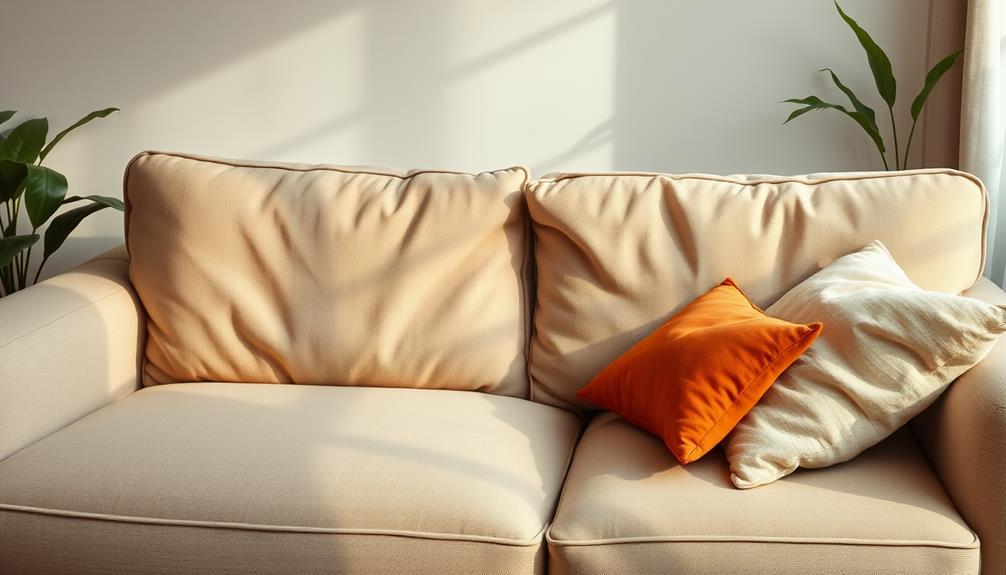
When you're shading your sofa drawing, it's essential to start with a light pencil to create a base layer. This initial layer sets the foundation for building darker tones, which add depth and dimension to your piece.
First, identify your light source. Shade accordingly, ensuring that areas opposite the light source are darker, enhancing realism.
Next, use a blending stump or your finger to smooth out your pencil strokes. This technique helps create seamless shifts between shaded areas and highlights, making your sofa look more lifelike.
Don't hesitate to experiment with cross-hatching by layering lines in different directions. This method not only creates texture but also enhances the appearance of upholstery.
Incorporate shadows beneath the sofa and around cushions. These shadows ground the drawing and contribute to a three-dimensional effect.
Pay attention to how the light interacts with the fabric; the more you observe, the better your shading will be.
Practice these techniques to refine your skills, and soon you'll see your sofa drawing come to life with rich textures and realistic depth.
Sharing Your Artwork

Sharing your artwork can be an exciting way to celebrate your creativity and connect with others. Once you've completed your sofa drawing, grab a clear photo in good lighting to showcase your masterpiece.
To maximize your reach, consider the following tips:
- Utilize Social Media: Post your finished drawing on platforms like Instagram or Facebook, using relevant hashtags to engage with fellow artists and art enthusiasts.
- Join Online Communities: Participate in art forums or groups where you can share your drawing and receive constructive feedback. These interactions can help you grow as an artist.
- Create a Digital Portfolio: Organize your artwork by creating a dedicated folder or album on your device. This way, you can easily track your progress over time and see how you've evolved.
Additionally, don't hesitate to invite friends and family to view your work. You can host a small showcase at home or organize virtual meetings to share your artistic journey.
Frequently Asked Questions
How to Draw a Sofa for Beginners?
To start drawing for beginners, break down complex shapes into simple forms. Focus on light pencil strokes for easy adjustments, then refine with bold lines. Experiment with colors to bring your creation to life and enhance its appeal.
How to Draw a 3 Seater Sofa?
You’d think drawing a three-seater sofa would be a breeze, right? Start with a big rectangle, carve it into three, add armrests, then legs. Finally, outline and detail your masterpiece—easy peasy! However, once you dive into the intricacies of proportions and comfort, things can get a bit tricky. You might find yourself wondering how to create a sofa table that complements your design perfectly. Balancing the dimensions and ensuring everything harmonizes adds another layer of challenge, but the satisfaction of a well-designed piece can make it all worthwhile.
How to Draw a Side Sofa?
To draw a side sofa, start with a large rectangle for the body. Add smaller rectangles for cushions, then shape the armrests. Don't forget the legs and texture to enhance your design's realism!
How to Draw Furniture in 2 Point Perspective?
To draw furniture in 2-point perspective, start by setting your horizon line and two vanishing points. Sketch the basic shapes, ensuring proportions are accurate, then add details, refining with shading for depth and realism.
Conclusion
As you finish your sofa drawing, remember that each stroke is like a thread weaving comfort into a cozy home. Your artwork reflects not just furniture, but the warmth and stories that fill a space. Embrace the journey of creativity, knowing that every line you draw represents a moment of inspiration. Share your finished piece, letting it symbolize the comfort you create for others—just like a well-loved sofa invites friends and family to gather and share in life's moments.
